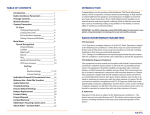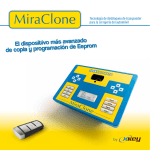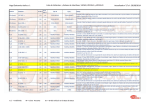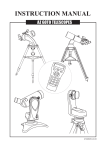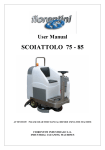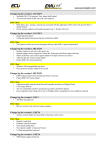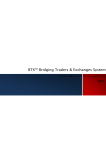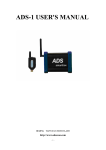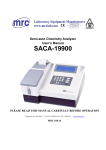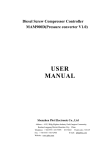Download GD860 If you have any technical questions, please contact Service
Transcript
Autosnap GD860 User’s Manual Tool Information Description: Auto Diagnostic Tool Model: GD860 If you have any technical questions, please contact Service Center • Email: [email protected] • Phone: +86-755-2815 4008 • Website: www.auto-snap.com Copyright Information Copyright © 2011 Autosnap Tech Co,. Ltd. All rights reserved. The information, specifications and illustrations in this guide are based on the latest information available at the time of printing. Autosnap Tech reserves the right to make changes at any time without notice. Autosnap GD860 User’s Manual Statement This User Manual is for diagnostic tool GD860. Without the prior written permission of Autosnap (Short for “Autosnap Tech Co., Ltd.”), any enterprise or person is NOT allowed to copy or store any data (electronic, mechanic, photo copying, recording etc). The information contained herein is only used for Autosnap GD860. Autosnap is not responsible for any damage by wrong use and as stated below. Autosnap shall not be liable for any part that has been abused, altered, used for a purpose other than for which it was intended, or used in a manner inconsistent with instructions regarding use. Other product names mentioned herein are for explaining how to use this device; the copyrights belong to the corresponding original enterprise. TradeMark Autosnap Tech Co., Ltd. registered the trademark of “Autosnap” in China and other countries. In any countries where Autosnap trademarks, service marks, logos and company name is not registered, Autosnap claims other right associated with unregistered trademarks, service marks, logos and company name. Without prior written permission, anyone is NOT allowed to use trademark, service mark, logo or company name of Autosnap. Autosnap GD860 User’s Manual Contents 1. General introduction··············································································································· 1 1.1Product features··············································································································································· 1 1.1.1 Generality ············································································································································· 1 1.1.2 Advancement ······································································································································· 1 1.1.3 Durability ············································································································································ 1 1.2 Using the GD860 ············································································································································· 1 1.2.1 Main unit and accessories ·················································································································· 1 1.2.2 Interface introduction ······················································································································· 3 1.3 Technical parameters ·································································································································· 3 1.4 Power switch ···················································································································································· 3 1.5 Touch screen calibration ···························································································································· 4 1.6 Button instruction ·········································································································································· 4 1.7 System setting ················································································································································ 7 1.7.1 Parameters setting ····························································································································· 7 1.7.2 Software version information ··········································································································· 8 2. Operation ············································································································································ 9 2.1 Preparation and cable connection ··········································································································· 9 2.1.1 Preparation ·········································································································································· 9 2.1.2 GD860 cable connection ··················································································································· 9 2.2 Diagnostics program ································································································································· 10 2.2.1 Available vehicle makes selection ································································································· 10 2.2.2 Entering into diagnostic program ······························································································· 11 2.3 Diagnostic options ········································································································································ 12 2.3.1 Reading trouble code ······················································································································ 12 2.3.2 Clearing trouble code ······················································································································ 12 2.3.3 Reading data stream ·························································································································· 12 2.3.4 Data stream text ·································································································································· 13 2.3.5 Data stream graphics ······················································································································ 13 2.3.6 Data stream graphics comparison ································································································· 13 2.3.7 Data stream dashboard ·················································································································· 14 2.3.8 Selection interface for data stream recording mode································································· 14 2.3.9 Normal mode ····································································································································· 15 2.3.10 Self-learning mode ························································································································· 15 2.3.11 Comparison mode ···························································································································· 17 2.3.12 Data stream recording ···················································································································· 17 2.3.13 Data stream playback ··················································································································· 17 2.3.14 Other diagnostic function ············································································································ 17 2.4 Data management ······································································································································ 18 2.5 Playback ······················································································································································· 18 2.6 Last diagnostic ·············································································································································· 18 Autosnap GD860 User’s Manual 3. Updating the GD860············································································································ 19 4. Powering the GD860 with external power supply······················· 21 5. Warranty and Service ······································································································· 22 Autosnap GD860 User’s Manual 1. General instructions 1.1 Product feature 1.1.1 General Information Covers more than 50 vehicle makes, including Asian, European and American vehicles, and hundreds of vehicle electronic systems. American Vehicles: GM, Ford, Chrysler European Vehicles: Mercedes-Benz, BMW, VW, Volvo, Citroen, Peugeot, Opel, Porsche, Land rover, Renault, FIAT, etc. Asian Vehicles: Toyota, Honda, Nissan, Mazda, Mitsubishi, Subaru, Nissan, Suzuki, Isuzu, Hyundai, Kia, Ssanyong, Chery, Brilliance, etc. 1.1.2 Advantages Multilanguage Support which allows it to be used in different countries and areas. Fashionable and robust design, high-resolution colorful touch screen combined with Electronic information technology that makes auto diagnosis more convenient, practical, accurate and economical. The PCB contains 6 layers circuit board which make the quality stable and strengthen the anti-interference. 1.1.3 Durability The integrative structural design is anti-falls, anti-seismic and durable. The industrialization design ensures that the product works stably even under adverse environments such as high-temperature, lowtemperature, etc. High-voltage class protection design which supports vehicles with 12V and 24V. 1 Autosnap GD860 User’s Manual 1.2 Using the GD860 1.2.1 Tool Description No. Name 1 Touch screen 2 Power light Communication light Communication light 3 4 5 Hot key 6 Nylon strap 7 Power switch 8 Bracket 9 Sticker Description Indicating operation buttons, testing information and help information. Storing diagnostic program and data. Internal communication indicator of main unit (HOST) Communication indicator between main unit and ECU. Touch screen Calibration or shortcut key for screen rotation. To prevent the main unit from falling by providing a secure grip of the unit Turn on or turn off the main unit. To support the main unit while standing it on dashboard, car fender or counter. Indicate the main unit information 2 Autosnap 1.2.2 NO. 10 11 12 13 GD860 User’s Manual Interface Introduction (as below figure) Name Diagnostic port Host USB port Description To connect the testing (OBD) cable To connect the USB data cable SD card port Slave USB port To insert the Micro SD card To connect the data cable 1.3 Technical Parameters Main Unit Size: 209mm (L)*173mm (W)*52mm (H) Operation System: WIN CE 6.0 CPU: 400MHZ ARM9 Memory: 64M Interface: USB 2.0 Power: DC12V, 2A Voltage: DC12V/DC24V Display Screen: 7 inch LCD touch screen (800 x 480) TFT 1.4 Power Switch Swith On: Press the power switch button for 2-3 seconds to switch on the scan tool, then the screen displays the following image. 3 Autosnap GD860 User’s Manual Switch off: Selection 1: Press the Power button on device, then click Yes to switch off the device when the message “Do you want to shutdown this device?” pops-up. Selection 2: Click the Close on touch screen, then click Yes to switch off the device when the message “Do you want to shutdown this device?” pops-up. 1.5 Touch Screen Calibration a) After turning on the device, press the GREEN button on the device, follow the display’s information to start calibration. b) Click the center cross on touch screen, the cross moves to another location after this spot is calibrated successfully. c) Repeat the operation as the cross moves, until the setting is finished. Press the screen again to return back to the home page. 1.6 Buttons Definitions Back to home page To rotate the display from horizontal screen to vertical screen, or from vertical screen to horizontal screen. 4 Autosnap GD860 User’s Manual To capture a picture of information displayed in the screen. Help information To load the diagnostic software and enter the diagnostics interface. To print the current contents of the display. (optional printer required) Exit from current interface or screen and back to previous. Store the present/new settings information. Recover the settings information to the default data. Cancel the current settings information. Enter into the selected menu option. Cancel the current operation. To accept/proceed with the current operation. Not to perform the current operation and go back to previous screen. 5 Autosnap GD860 User’s Manual Records the current live data, save it for later playback and analysis. The minimal recording time is 5 seconds. After clicking the [Record] button for 5 seconds, the [Stop Record] button will be available and showed. Click [Stop Record] button, recording stops and the data will be saved. Continue live data’s real-time display and playback. Data stream pauses and stops at the current data, and data values will not be updated. It’s used to observe and analyze the displayed data. Move up to the previous page. Move down to the next page. Delet the selected document. Enter the diagnostics inteface to select the desired vehicles brand and start to diagnose. Set the system, such as language, date, display orientation, and etc. Playback the recorded data. Manage system data, such as recorded data, diagnostic software, and etc. 6 Autosnap GD860 User’s Manual Diagnose the same vehicle brand as previous time. It’s convenient to diagnose the same brand vehicle without selecting the relevant vehicle information. Turn off the power to the unit. 1.7 System Setting 1.7.1 Parameter setting Click on the button [System Setting] of home page to set various parameters and information. (The figure as shown at below) Parameter setting a) Laguage setting: Click the sign “▼”to select desired language and press the button Store to finish language setting. After you change the setting, please restart the system to set it for future uses. b) System date: Click the sign “▼” to select the correct date and press the button Store to finish date setting. c) System time: Click the sign “▼” to select the correct time and press the button Store to finish date setting. d) Display mode: Click the sign “▼” to select the desired default display mode. The display interface will be vertical when you select Portrait display, its horizontal when you select Landscape display. You can temporarily change it by clicking the Screen Rotation icon at the top of the screen. e) Store location of picture: Click the sign “▼” to select the location where you want to store the pictures you snap-shot. Either, store the pictures in internal memory or SD card, use Data management to review and manage them. f) Vehicle order: 7 Autosnap GD860 User’s Manual [Sort in usage freq]: The vehicles logo will be arranged in order according to using frequence. The more frequent you use the vehicle logo, the most forward it displays in [Diagnostic software]. [Sort in alphabetic order]: The vehicles logo will be arranged in alphabetical order in [Diagnostic software] g) Diag COM: To select the communication serial port. The default serial port is COM3, normally no need to modify it. h) Baud rate: To select the serial port baud rate, the default baud rate is 19200, normally no need to modify it. i) Printer COM: To select the printer serial port, the default serial port is COM7, normally no need to modify it. j) Printer Baud Rate: To select the printer baud rate, the default printer baud rate is 115200, normally no need to modify it. k) Adjust Brightness: Controlled by scrolling along the bar to increase or decrease the contrast. Note: After you have changed settings, please click the [Save] button to accept and save the changes, if you want to discard the present settings please click the [Cancel] button, if you want to recover the default settings please click the [Restore] button. 1.7.2 Version information Click on the [Version] tab to get the current information on Software version, Hardware version, Software Serial number, Production date. 8 Autosnap GD860 User’s Manual 2. Operation 2.1 Preparation and OBD cable connection 2.1.1 Preparation The connector selection There are various connectors packed with the main unit. Every connector has an application, please check the connector application carefully and select the correct connector for the vehicle being diagnosed. Location of the Data Link Connector The location of the data link connector is usually in the left side under the dash, behind covers on center of dash or center console, but there are 8 common locations as show below. 2.1.2 Cable connection 1) Find out the location of the DLC and check the type of DLC to see if external power supply is required 2) Select corresponding connectors for car make and DLC. 3) Connect one end of main OBD cable to the main unit and the other end to the appropriate connector selected. 4) Plug the cable assembly with connector into the DLC on car. 9 Autosnap GD860 User’s Manual 5) Turn on the unit using the power button to start testing. Please refer to below figure to learn how to connect to get power supply There are 3 ways to get power: a. AC Power supply b. Vehicle DLC c. Cigarette lighter 2.2 Diagnose procedure 2.2.1 Select available vehicle makes GD860 can diagnose various makes of vehicles, Autosnap keeps updating to enhance the software. Please visit the Autosnap website to download the latest updated software. All of the GD860 diagnostic programs are identified with the brand’s vehicle logo as buttons, click on the corresponding vehicle logo to load that diagnostics software. It’s very useful and fast to enter into a diagnostic system if you are familiar with the vehicle logos. There are different software packages for different user needs according to country and 10 Autosnap GD860 User’s Manual vehicle makes. For the software in your unit, please refer to the packing list or contact the local distributor. 2.2.2 Enter diagnostics program After connecting to the DLC and power supply (if required), press the [Power] button for 2-3 seconds to start the GD860. After clicking on the [Diagnosis] button, you will enter the diagnostic screen where you can select the origin of the vehicle manufacturer. Screen shows: Asia, Europe, America and OBD II. [America] is selected as default, click on the [Asia] button when you want to diagnose Asian vehicles, please click on the [Europe] button when you want to diagnose European vehicles Please refer to the figure as shown at right: Click on the [OBDII] button and select the desired software version from the drop-down menu. By default, the software version will update to the latest version automatically. All of high versions software is compatible with low version software. Note: Clicking the [OBD II] button, this diagnostic program can test all vehicles with OBDⅡ/ EOBD and CAN-OBD. Click the [Start Diagnosis] button, the figure as shown to the right will appear after the software loads: Click on [Generic OBDII _EOBD] to start automatic detection of the vehicle’s protocol or click the appropriate protocol if you know it. 11 Autosnap GD860 User’s Manual 2.3 Diagnostic options 2.3.1 Read DTCs Select “Read trouble code” to retrieve stored trouble codes. On the next screen you can select Generic or vehicle make specific codes. 2.3.2 Choose “Clear trouble code” to delete all trouble codes. 12 Autosnap GD860 User’s Manual 2.3.3 Review Data Stream Click “Current powertrain diagnostic data” in menu, then on the next screen click “Current Powertrain Diagnostic Data”, next click the “Normal” tab followed by the “OK” button. Now select the item(s) preferred to review data. As showed in right picture: Select the desired datastream items and click the [OK] button to read: There will be four ways available to display datastreams: -Text, -Graph, -Graph Comparison (if more than one item was selected) and, -Dashboard. 13 Autosnap GD860 User’s Manual 2.3.4 Text Display: The default display is in text. 2.3.5 Graphic Display Click [Graph], the data stream would be displayed in a grid, as the picture at right. 2.3.6 Merging Graphic Displays Click [Graph Comparison], different datastreams would be simutaniously displayed in the same graph chart and make comparisons. 2.3.7 Dashboard Display Click [Dashboard], the datastreams display in the way of analog gages, and select different datastreams for each gage to make comparisons on the same page. 14 Autosnap GD860 User’s Manual 2.3.8 Datastream Memory Modes. There are three memory modes available for recording datastream. a) Normal Mode: normal mode is the defult mode in system. Under this mode, users can diagnose or retrieve data from sensors of all kinds of vehicles subsystems such as engine, auto transmission, and brake sytems. This mode is suitable for general use. b) Self-learning Mode: Self-learning mode is to record data for later comparison with live data using the Comparison mode. Comparison mode: Comparison mode is used for displaying live data to compare against the minimum and maximum span of recorded data. c) Note: Under self-learning mode, users select working condition of the vehicle used to record the data. All recordings from self-learning mode are listed in the comparison mode list. They should contain record date, vehicle model, software version, duration, working mode, engine mode and description. Select from working condition and other recorded datastream descriptions to make comparisons of same type live data. 2.3.9 Normal Mode Normal mode: In normal mode you can select which parameters to display. After making the selections, click [OK] to start viewing the live data. This data can be seen in Text, Graph, Graph Comparison and Dasboard modes. Normal mode button is shown in figure at right: 2.3.10 Self-learning mode Self-learning mode: Is used to record live data of all parameters available at a particular working or operating condition to later compare with other live data. Operation: Click [Self-learning] mode Select working condition Click [OK] view live datastream and record Click [Back] stop recording and exit present page Click [Yes] to input vehicle information Click [OK] to store records. Example is showed in the next pictures: 15 Autosnap GD860 User’s Manual 16 Autosnap GD860 User’s Manual 2.3.11 Comparison mode Comparison mode is used to view recorded data from diagnosed vehicles; data can be based on good working parameters recorded under self-learning mode to compare to live parameters of vehicles having problems. Keep in mind to make comparisons of same make, model, engine and operating/working conditions to get accurate comparisons. Operation: Click [Comparison mode] Select recorded data matching the working condition mode and other information similar to the vehicle being diagnosed click [OK] and select the parameters to compare click [OK] to view the live data in Text mode click the [Graph] tab to view comparison of recorde and live data at the same time in graph mode. Note that the recorded data only shows as minimum and maximum graph readings in the form of RED lines in the grids. Live data should be within the red lines to be considered good. Again, make sure that you are comparing the same type of data from vehicle, engine, operating condition, etc. 2.3.12 Live Data Records. Live Data Recording is used to record currently displayed live data. The data is saved as file records which can be played back and be analyzed. Note: The live data recording should last at least 5 seconds. After 5 seconds users can stop recording by clicking the “Stop Record” button. Operation: click [Record] click [Stop Record] input the recorded vehicle’s information with the various descriptions of the datastream click [OK] to save. 2.3.13 Playback The playback interface is used to playback the stored recorded files, which display the files by vehicle working condition and other kinds of parameters. Operation: Click [Data Playback] in main interface Select the desired record for playback click [Playback] You can view the recorded data in Text, Graph, Graph Comparison and Dashboard modes. Click [Play Again] to replay the same file. 17 Autosnap GD860 User’s Manual 2.3.14 Other Functions This manual describes the device’s basic operations and functions. Diagnostic software for different vehicle brands may differ in some functions, especially in operation of some special settings and adaptation functions. This manual will not offer detailed description. When using the device and no reference is found in this manual, please refer to operation tips and help notes in the system. 2.4 Data Management Select [Data Management] in main interface to conduct various data functions, including deletion of recorded files, vehicle diagnostic software information and deletion, screenshot image viewing and deletion. 2.5 Data Playback Select [Data Playback] in main interface to review the recorded files, playback files to analyze the data. 2.6 Last Diagnosis Select [Last Diagnosis] in main interface, the system will automatically load the diagnostic program of the last vehicle scanned without the need of selecting the brand, which is convenient for repeat diagnosis on the same vehicle make. 18 Autosnap GD860 User’s Manual 3. Updating the GD860 How to register and update software on www.gd860.com? 1. Click “Registration” button on right corner of website to enter the registration interface. 2. Input the information as requested. The registration will be activated after confirmed by Autosnap. The fields below with * need to be filled as required. Note: The Serial Number, Product password and Dealer code will be provided by Autosnap via an email. 19 Autosnap GD860 User’s Manual 3. Login with user name and password 3. Download the software Step 1: Enter into the “Software Download” interface Click here to download the software Step 2: Download and install the software “Update tool” on your computer Step 3: Download the vehicles software and save on your computer Step 4: Update the software 20 Autosnap GD860 User’s Manual Open the update tool and browse the vehicles software, and then Click “Update” button to update the software Note: Before updating, please connect the power supply to device, and connect device to computer with USB cable. Please see next page. 4. Using the AC external power supply The external power supply is used for updating and turning on the GD860 to view stored data in it. Step 1: Plug the wall power cable to the transformer Step 2: Plug the transformer cable to the external feed wire on the main OBD II cable Step 3: Press the “Power” button on the GD860 Step 4: Connect the USB cable to GD860 and other end to the PC Step 5: Proceed to “Step 4” on previous page to start the update OR work with stored data files by pressing the “Data Management” or “Data Playback” buttons. 21 Autosnap GD860 User’s Manual 5. Warranty and Service 5.1 Warranty 1) 2) 3) 4) 5) 6) This warranty is expressly limited to persons who purchase Autosnap products for purposes of resale or use in the ordinary course of the buyer’s business. It’s subject to the following terms and conditions: Autosnap product is warranted against defects in materials and workmanship for one year (12 months) from date of delivery to the user. The sole responsibility of Autosnap under the Warranty is limited to either the repair or, at the option of Autosnap, replacement of the tool at no charge with Proof of Purchase. The sales receipt may be used for this purpose. This warranty does not apply to damages caused by improper use, accident, flood, lightning, or if the product was altered or repaired by anyone other than the Manufacturer’s Service Center. Autosnap shall not be liable for any incidental or consequential damages arising from the use, misuse, or mounting of the tool. Some states do not allow limitations on how long an implied warranty lasts, so the above limitations may not apply to you. No agent, employee, or representative of Autosnap has any authority to bind Autosnap to any affirmation, representation, or warranty concerning Autosnap automotive meters, except as stated herein Autosnap reserves the right to make changes at any time without notice. 5.2 Service 1) Order Parts Replaceable and optional parts can be ordered directly from the authorized Autosnap distributors. 2)Service Procedures If you have any questions, please contact your local distributor first. If it becomes necessary to contact Autosnap, please find our contacts below: Autosnap Service Center: Company: Autosnap Tech Co., Ltd. Add: 3rd Floor, Jianda Building, Hi-Tech Industrial Park, Nanshan District, Shenzhen, China Tel: +86-755-8299 5063 Fax: +86-755-2815 5123 E-mail: [email protected] 22


























